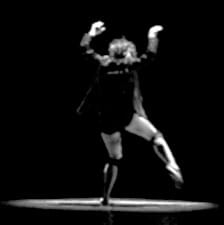ASzURe & Artists in New York at the Joyce SoHo refresh the soul
With the energy of a carnival and the effect of an elixir, Aszure Barton and her company of superb, sexy dancers swept across the stage for an hour of sensuous, visually dramatic, and soul-refreshing dancing in their official New York City debut at the Joyce SoHo. Barton, a Western Canadian with credentials from the National Ballet and Les Ballet Jazz de Montreal, has an engaging movement palette that blends jazzy, quirky movements with percussive footwork and strong technical grounding. Accompanied by a range of celebratory world music, this was a welcome and unashamed expression of what is right with the world.
The audience was welcomed as the cast, dressed in formal attire, entered from the house, to cartoony jazz music by Raymond Scott, in a prologue entitled “places please…,” setting the tone of levity for the evening.
“Mikazaru, Mizaru, Mazaru,” a series of three solos, showcased the movement styles of the choreographer and the personalities of its three performers. Banning Roberts appeared strong and manic—and always intensely focused—as she danced sharply, moving high, low, and off-balance to a discordant arr-angement of string instruments by Peter Kowald with Grüner Mori. The second variation, performed by Lesley Kennedy was similarly about balance, but here the movement began in silence, with eyes closed, and the space was explored delicately, limbs stretching out slowly as if feeling the way. Chimes introduced the seductive silhouette of the third soloist, Chèrice Barton, whose presence re-mained powerful throughout the evening. Her movement, as she approached the audience backwards, was slinky, shoulders and hips loose and rolling, an undulating come–hither, animal quality to every move.
The main event, entitled “Mais We, in 22 soles,” was a series of visceral, interconnected vignettes that bounced and charged and overwhelmed the senses. Evocative, manic, jazzy, bouncy, sexy, sinewy, stylish, and exotic, it had the all the accoutrements and sensual pleasures of a very promising first date. Ten dancers, all on stage together dressed in black jacket and pants slowly became visible. Facing away from the audience, their box step unison slowly evolved into a complex arrangement of synchronized movements. This theme of uniformity, while repeated in visual motifs, nevertheless unraveled with each progression. A tab-leaux of women, at first still, then suddenly a moving orgy of gestures all different, somehow formed a cogent whole. A solo for William Briscoe to drumming and song made him hinge and reach behind himself, as his limbs rolled and swung loose and purposeful, like those of a bird alighting. Even a procession that begins with balletic accumulation cannot quiet the ebullience of this work.
Laughter, screaming, and audience shoes are not exempt from the material, either. The ensemble reemerges from the frequent darkness at one point draped in long black robes with white cuffs, a style nod to “The Matrix,” but this cliché is quickly drummed away by the dancers percussive stamping and synchronized steps which make no reference to the movie’s signature moves—the visual is (re)loaded enough. Barton reappears, re-captivating, in red dress and tall boots moving in spurts of gestures, side steps, and torso rolls to Latin music. Her more wistful movement is followed by an outburst of athletic ensemble dancing with phrases repeated from Briscoe’s solo. At the end, the troupe reappears in the robes, undressing one by one as they enter, before falling together to the floor, leaving only two dressed dancers still standing.
The cast included Éric Beauchesne, Peter Chu, Tamara Dyke, Victoria Lundell, Charissa Braton, and Chesaré Hardy. The fine costumes were designed by Deanna Berg. It would be negligent not to mention Daniel Ranger’s lighting design, which added to the drama of the physical and visual presentation. Despite the constraints of the space, Ranger produced effects that artfully shaped the space and the emotions of the performance, as effectively as if it had been done in a high-end theater.
We also publish:



































